Discover Florida Nature
It's time to explore the natural Florida


|
|
|
|
|
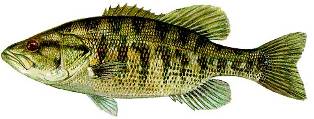 Suwannee
Bass (Micropterus notius) SSC- Originally restricted to the
Suwannee and Ochlockonee River systems of Florida and Georgia, the
Suwannee bass also occupies spring-fed lower reaches of the Santa Fe and
Ichetucknee rivers, tributaries of the Suwannee River and the St. Marks
and Aucilla/Wacissa systems where it was introduced. The Suwannee bass
is a heavy-bodied bass seldom exceeding 12 inches long. The most unique
characteristic of a mature Suwannee bass is its bright turquoise, blue
coloring on the cheeks, breast, and ventral parts. The upper jaw does
not extend beyond the eye. Also, there is a shallow notch between the
dorsal fins with a distinct connection between the spiny and soft-rayed
dorsal fins. Young fish feed on aquatic insects and small crustaceans.
Larger fish feed heavily on crayfish and also take small fishes. Suwannee
Bass (Micropterus notius) SSC- Originally restricted to the
Suwannee and Ochlockonee River systems of Florida and Georgia, the
Suwannee bass also occupies spring-fed lower reaches of the Santa Fe and
Ichetucknee rivers, tributaries of the Suwannee River and the St. Marks
and Aucilla/Wacissa systems where it was introduced. The Suwannee bass
is a heavy-bodied bass seldom exceeding 12 inches long. The most unique
characteristic of a mature Suwannee bass is its bright turquoise, blue
coloring on the cheeks, breast, and ventral parts. The upper jaw does
not extend beyond the eye. Also, there is a shallow notch between the
dorsal fins with a distinct connection between the spiny and soft-rayed
dorsal fins. Young fish feed on aquatic insects and small crustaceans.
Larger fish feed heavily on crayfish and also take small fishes.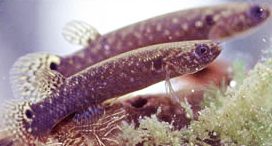 Rivulus
(Rivulus marmoratus) SSC- The mangrove rivulus is the only
rivulus found in North America and its presence in our waters was only
recently detected. The mangrove rivulus is primarily a saltwater or
brackish water species, with limited occurrence in freshwater. It can
tolerate salinities from 0-68 parts per thousand. Within the Everglades
and along Florida's west coast, this fish occurs in stagnant, seasonal
ponds and sloughs as well as in mosquito ditches within mangrove
habitats. Along the east coast of Florida, it resides in elevated marsh
habitats above the intertidal zone, often within the burrows of the
great land crab. This fish can reach a maximum size of 2 inches (5 cm)
in length, however it is more commonly observed at lengths between
0.4-1.5 inches (1.0-3.8 cm). Predators include other fish and wood
storks, as well as possibly the Atlantic saltmarsh snake which is often
found in crab burrows containing mangrove rivulus. Rivulus
(Rivulus marmoratus) SSC- The mangrove rivulus is the only
rivulus found in North America and its presence in our waters was only
recently detected. The mangrove rivulus is primarily a saltwater or
brackish water species, with limited occurrence in freshwater. It can
tolerate salinities from 0-68 parts per thousand. Within the Everglades
and along Florida's west coast, this fish occurs in stagnant, seasonal
ponds and sloughs as well as in mosquito ditches within mangrove
habitats. Along the east coast of Florida, it resides in elevated marsh
habitats above the intertidal zone, often within the burrows of the
great land crab. This fish can reach a maximum size of 2 inches (5 cm)
in length, however it is more commonly observed at lengths between
0.4-1.5 inches (1.0-3.8 cm). Predators include other fish and wood
storks, as well as possibly the Atlantic saltmarsh snake which is often
found in crab burrows containing mangrove rivulus.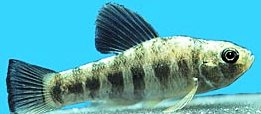 Lake
Eustis Pupfish
(Cyprinodon variegatus hubbsi) SSC- This subspecies is very similar to
the much more common sheepshead minnow. Small, typically 2 - 3 inches,
the lake Eustis pupfish is a stout, deep-bodied fish with clear dorsal
and caudal fins. The general body color is beige to olive with dark,
irregular stripes. Known only from a group of interconnected lakes that
form the headwaters of the Oklawaha River, the Lake Eustis pupfish is
only found in Lake Orange and Marion County Florida. The lake Eustis
pupfish inhabits a very narrow shallow zone of shoreline that is usually
devoid of vegetation. Lake
Eustis Pupfish
(Cyprinodon variegatus hubbsi) SSC- This subspecies is very similar to
the much more common sheepshead minnow. Small, typically 2 - 3 inches,
the lake Eustis pupfish is a stout, deep-bodied fish with clear dorsal
and caudal fins. The general body color is beige to olive with dark,
irregular stripes. Known only from a group of interconnected lakes that
form the headwaters of the Oklawaha River, the Lake Eustis pupfish is
only found in Lake Orange and Marion County Florida. The lake Eustis
pupfish inhabits a very narrow shallow zone of shoreline that is usually
devoid of vegetation. Blackmouth
Shiner (Notropis melanostomus) Endangered- A small (less than
1.5-inch long) streamlined shiner that occurs only in the
Blackwater-Yellow River system (Pensacola Bay drainage). Blackmouth
Shiners are fairly nondescript and can be mistaken for other
superficially similar minnows and young shiners Population has been
reduced to an endangered number by the encroachment of people into this
limited habitat. They are found in backwaters and quiet pools of creeks
and small rivers; usually over mud near vegetation. Urban and industrial
development of the Milton, Florida, region is rapidly degrading habitat
and it is feared that extinction of the Florida population of the
Blackmouth Shiner is likely in foreseeable future. Blackmouth
Shiner (Notropis melanostomus) Endangered- A small (less than
1.5-inch long) streamlined shiner that occurs only in the
Blackwater-Yellow River system (Pensacola Bay drainage). Blackmouth
Shiners are fairly nondescript and can be mistaken for other
superficially similar minnows and young shiners Population has been
reduced to an endangered number by the encroachment of people into this
limited habitat. They are found in backwaters and quiet pools of creeks
and small rivers; usually over mud near vegetation. Urban and industrial
development of the Milton, Florida, region is rapidly degrading habitat
and it is feared that extinction of the Florida population of the
Blackmouth Shiner is likely in foreseeable future.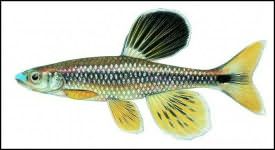 Bluenose
Shiner (Pteronotropis welaka) SSC- The spectacular colors
exhibited by male bluenose shiners in breeding condition place them
among the most beautiful minnows in North America. As the common name
indicates, breeding males have bright blue snouts. The extremely
enlarged dorsal, pelvic, and anal fins are also colorful. Bluenose
shiners usually inhabit quiet backwaters and vegetated pools of streams
and rivers. These pools generally have bottoms of mud or sand, with
abundant growths of golden club and other aquatic vegetation. In Florida
the bluenose shiner can be found in the western panhandle, from Jackson
county to Escambia county and the upper tributaries of the St. Johns
River. Bluenose
Shiner (Pteronotropis welaka) SSC- The spectacular colors
exhibited by male bluenose shiners in breeding condition place them
among the most beautiful minnows in North America. As the common name
indicates, breeding males have bright blue snouts. The extremely
enlarged dorsal, pelvic, and anal fins are also colorful. Bluenose
shiners usually inhabit quiet backwaters and vegetated pools of streams
and rivers. These pools generally have bottoms of mud or sand, with
abundant growths of golden club and other aquatic vegetation. In Florida
the bluenose shiner can be found in the western panhandle, from Jackson
county to Escambia county and the upper tributaries of the St. Johns
River.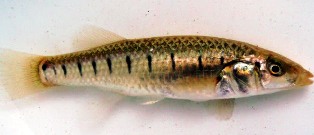 Saltmarsh
Topminnow (Fundulus jenkinsi) SSC- The saltmarsh topminnow is
one of the smallest topminnows seldom exceeding 1.5-2.0 inches. It is
believed the species only lives for one to two years, making this
species vulnerable to drastic year class variations and susceptible to
local extinctions. Saltmarsh topminnows breed in shallow flooded marshes
from the north-central coast of the Gulf of Mexico to western Florida.
It is believed that specimens can be found in the Perdido, Escambia, and
East Bays of Florida. They are generally associated with salt marshes
and brackish water, but can survive in fresh water. Habitat alteration,
dredging, and marsh erosion are the most serious threats to the
saltmarsh topminnow. Saltmarsh
Topminnow (Fundulus jenkinsi) SSC- The saltmarsh topminnow is
one of the smallest topminnows seldom exceeding 1.5-2.0 inches. It is
believed the species only lives for one to two years, making this
species vulnerable to drastic year class variations and susceptible to
local extinctions. Saltmarsh topminnows breed in shallow flooded marshes
from the north-central coast of the Gulf of Mexico to western Florida.
It is believed that specimens can be found in the Perdido, Escambia, and
East Bays of Florida. They are generally associated with salt marshes
and brackish water, but can survive in fresh water. Habitat alteration,
dredging, and marsh erosion are the most serious threats to the
saltmarsh topminnow.
|
|
|
Advertise | Privacy Statement | Dog Encyclopedia | Video |Contact | Alaska Nature |
|